(c) Joanne Mattera www.joannemattera.com
The "friendly" part was built into the fair’s criteria. Producers Matt Garson of M% and Julie Baker of Julie Baker Fine Art,  invited galleries from around the country not only for the quality of their programs but for the personality of the dealers. They wanted an attitude-free zone. And they got it. Of all the fairs, Flow was the most fun.
invited galleries from around the country not only for the quality of their programs but for the personality of the dealers. They wanted an attitude-free zone. And they got it. Of all the fairs, Flow was the most fun.
Flow Fair at the Catalina Hotel on Collins Avenue
Let me start with a disclaimer. I’m represented by two galleries that showed here: Kenise Barnes Fine Art, which included several of my paintings, and the Marcia Wood Gallery. But I’m not the only one saying nice things about this show and its galleries. Robert Ayers filed his December 8 Art Info report with this lead: "If we were to offer a "Fairest of the Fairs" award, then…Flow would be the front runner."
The virtue of a small fair such as this (and of Aqua Art, which I'll tackle in the next blog installment) is that it's just not possible to saunter and browse. Smaller exhibition spaces make for more concentrated viewing.
At PDX Contemporary Art I loved the work of Marie Watt, who reclaims materials for her geometric collages (you could also call them stitched paintings) and sculptures. I’ve seen this Portland, Oregon, gallery at other fairs and am always impressed with director Jane Beebe’s esthetic, which includes a strong object and textile sensibility
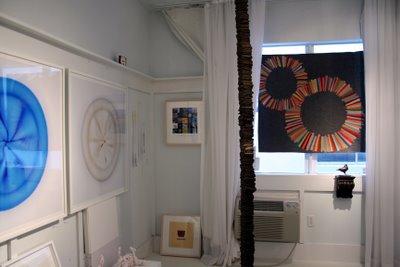
Marie Watt: Sculpture (wood) and collage (wool) from reclaimed materials at PDX Contemporary, Portland, Oregon
Across the hall, Miller Block Galley was featuring the work of, among others, Jane Masters, 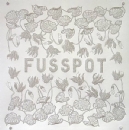 who creates embroidery-like drawings with a fine-pointed burning tool. I pulled this image from the gallery’s website because my own shots in the room were too blurry to use. (Low light and small quarters = many out-of-focus images.)
who creates embroidery-like drawings with a fine-pointed burning tool. I pulled this image from the gallery’s website because my own shots in the room were too blurry to use. (Low light and small quarters = many out-of-focus images.)
Jane Masters: Fusspot, burned paper, at Miller Block Gallery, Boston
Kenise Barnes Fine Art featured an installation in which pattern and color prevailed: Margaret Lanzetta’s fern-and-floral arabesques, Tricia Wright’s geometric florals, Mary Judge’s compelling monoprint mandalas, and my own small, slub-textured color fields in encaustic.
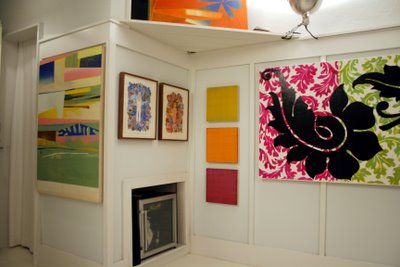 You get an almost 360-degree view of the installation at Kenise Barnes Fine Art in this image and the ones below. From left: David Collins painting, Lucy Fradkin framed gouache figures on paper; my three Silk Road paintings; Margaret Lanzetta large-scale arabesques. Below: Kenise standing in front of a painting by Tricia Wright
You get an almost 360-degree view of the installation at Kenise Barnes Fine Art in this image and the ones below. From left: David Collins painting, Lucy Fradkin framed gouache figures on paper; my three Silk Road paintings; Margaret Lanzetta large-scale arabesques. Below: Kenise standing in front of a painting by Tricia Wright

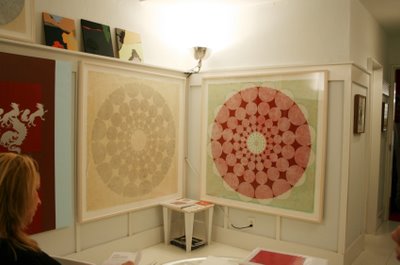
Mary Judge's mandala monoprints at Kenise Barnes Fine Art, Larchmont, New York
At the Roy Boyd Gallery, pattern and color also prevailed. This Chicago gallery shows a number of artists whose work never disappoints: Marcus Linnenbrink, Carlos Estrada Vega (see my mention of his work in the blog, Two Artists Talking) and Teo Gonzalez. 
Here's Roy Boyd, sitting amid the Linnenbrinks

Carlos Estrada Vega: Walt, oleopasto on individual canvas-wrapped squares, 10 x 10" at Roy Boyd Gallery, Chicago
The installation at the Marcia Wood Gallery was all about the reward of seeing beyond the surface of things, from Peter Bahouth’s stereoscopic images that must be seen through a special viewer, to Devorah Sperber’s pixilated images viewed through a sphere (see my blog mention of her work in "The Centered Eye"), to Mary Engel’s made-you-look-twice animal-encrusted animals.
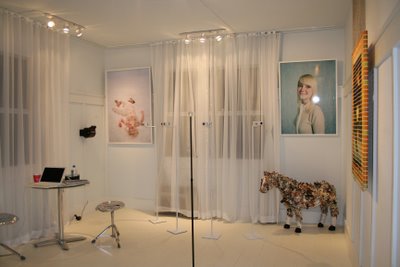
Installation at the Marcia Wood Gallery, Atlanta: Chris Scarborough pixel-manipulated photographs and Mary Engel animal sculpture. Harder to see are Peter Bahouth's viewing stands (in front of the window) and an oblique view of Devorah Sperber's pixilated installation with its viewing spere atop the dark stand in the middle of the picture. Below: a mono view of Peter Behouth's stereoscopic image, Lamb Henge

I also liked the installation of small semi-geometric abstractions in encaustic by Lenore Thomas at M% Gallery, and Eric Garduno’s small acrylic-sandwich geometric abstractions, inspired by Sixties LPs, at Linda Durham Contemporary Art, where they were displayed on a narrow ledge. "He likes to think of them as objects," says Durham.

Lenore Thomas's abstractions in encaustic at M% Gallery, Cleveland; below, Linda Durham with Eric Garduno's LP-inspired geometries on the ledge at Linda Durham Contemporary Art, Santa Fe
 Word spread quickly that the Toomey Tourell gallery had sold everything early on. This San Francisco gallery has a varied program that includes abstraction and figuration, including the cartoony narratives of Heather Wilcoxon, the metallic color fields of Jimi Gleason and the map-like constructions of Matthew Picton. And with that good news I'll close this installment.
Word spread quickly that the Toomey Tourell gallery had sold everything early on. This San Francisco gallery has a varied program that includes abstraction and figuration, including the cartoony narratives of Heather Wilcoxon, the metallic color fields of Jimi Gleason and the map-like constructions of Matthew Picton. And with that good news I'll close this installment.
Below, Artist Matthew Picton and dealer Nancy Toomey of San Francisco's Toomey Tourell Gallery seated with Picton's cut-paper works over their left shoulders













